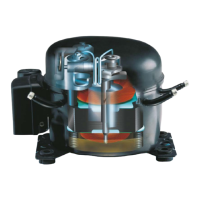11
4.1
Connectors
4.
MOUNTING
Brazing problems caused by oil in the connectors can be avoided by placing the compressor on its base plate
some time before brazing it into the system. The compressor must never be placed upside down.
The system should be closed within 15 minutes to avoid moisture and dirt penetration.
The positions of connectors are found in the sketches. “C” means suction and must always be connected to
the suction line. “E” means discharge and must be connected to the discharge line. “D” means process and
is used for processing the system.
Most compressors are supplied with sealed connectors, which consist of a thick-walled copper plated steel
tube with great corrosion resistance and good braze ability. The connectors are welded in the compressor
housing and thus the weld cannot be destroyed by overheating during brazing operations. The seal is an
aluminum cap which gives a tight seal. Compressor with copper connectors are sealed with rubber plugs.
The aluminum cap sealing ("capsolut") offers a tight seali. The seal ensures that the compressors have not
been opened after leaving Secop´s production lines. In addition to that, the seal makes a protecting charge
of nitrogen superfluous.
220 V compressors are normally supplied with millimeter tubes, while 115 V compressors are supplied with
inch tubes. All connectors have a shoulder to provide optimal brazing conditions. Expanding the connectors
by more than 0.3 mm / 0.01 inch in is not allowed.
Compressors with an “S” in the model denomination and all NL/DL/SCE types have a direct intake system,
which means increased capacity. The suction connectors at these compressors must be connected to the
suction line to prevent capacity loss.
For the refrigerants R600a and R290, process tubes can be closed with a LOKRING® connection.
Brazing is not allowed on systems with flammable refrigerants.

